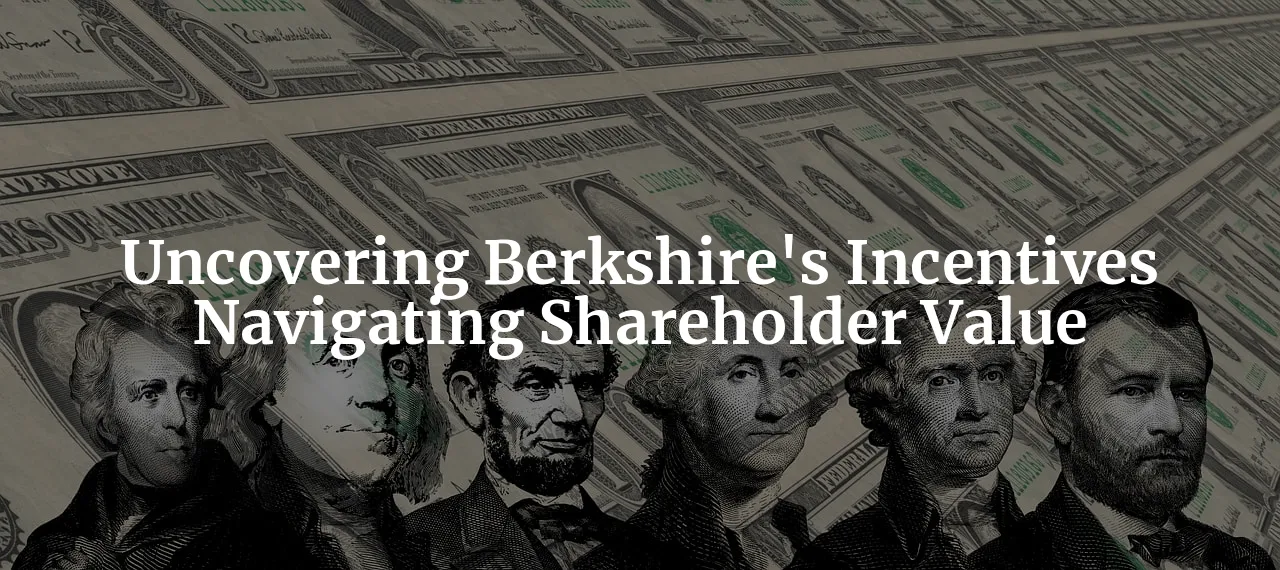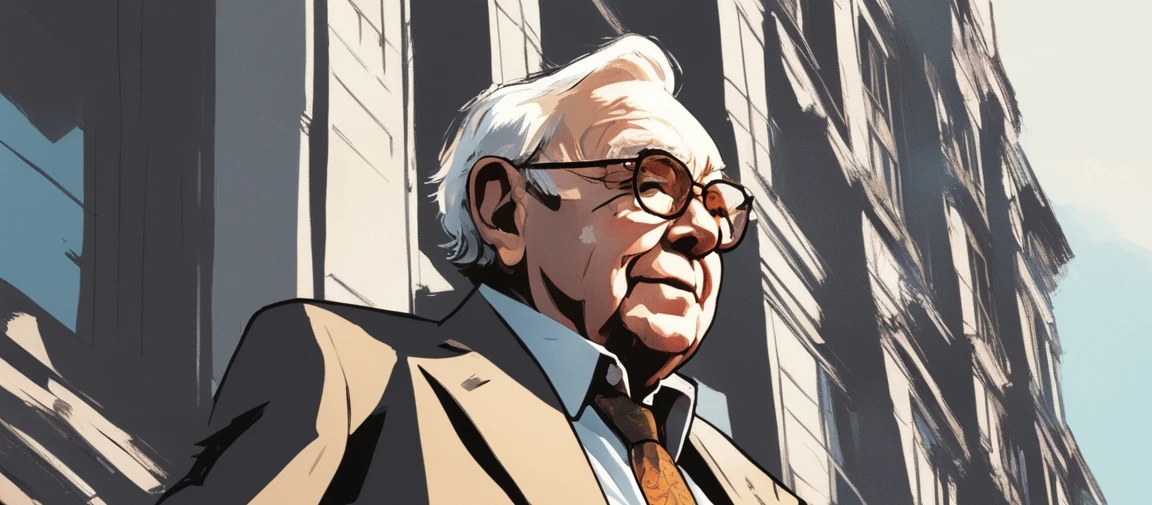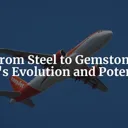Tags: Comments / Charlie Munger / Warren Buffett
This fanpage is not officially affiliated with Berkshire Hathaway: Disclaimer
Dive into the fascinating world of incentives and corporate culture as we uncover the secrets behind Berkshire Hathaway's success. Learn how the company's unique incentive structure has propelled it to the top, and gain insights that can help you navigate the complex world of shareholder value.

Introduction
"Show me the incentive, and I will show you the outcome," Charlie Munger famously stated 1. This powerful assertion underscores the profound impact incentives have on corporate culture and performance. At the heart of Berkshire Hathaway, our well-beloved sprawling conglomerate with a storied history, lies a unique incentive structure meticulously crafted by Warren Buffett and Charlie Munger. This structure is not just a framework for operations; it is a testament to a culture that deeply aligns with shareholder interests.
In this article, we will delve into the intricacies of Berkshire Hathaway's incentive system and uncover how it has fostered an environment conducive to long-term benefits for its shareholders. Through the lens of historical performance data, political contexts, and economic insights, we aim to provide a comprehensive analysis of the strategic decisions and corporate governance that have propelled Berkshire Hathaway to its esteemed position in the business world.
Understanding the incentives at play is crucial to appreciating Berkshire Hathaway's success ↗. As we explore the company's past and present, we will see how a deep-rooted philosophy in value creation has guided its trajectory. Let us embark on a journey to discover how Berkshire Hathaway has become a shareholder's best friend through its powerful incentive structure.
The Power of Economic Goodwill: Journey to 1985
The term "economic goodwill" might sound like corporate jargon, but for Berkshire Hathaway, it represents a cornerstone of their financial philosophy—one intricately tied to their unique incentive structure. This concept seamlessly translates the principles of their incentive system into tangible results. Economic goodwill refers to the intangible yet potent force that enables a business to earn more money with relatively little additional capital investment, showcasing the practical application of Berkshire Hathaway's distinct incentives aimed at long-term value creation. Back in 1985, Berkshire Hathaway's pre-tax earnings from businesses such as Nebraska Furniture Mart ↗ and See's Candy Shops ↗ soared from $8 million to an impressive $72 million over a 15-year period, while only requiring an additional $40 million in invested capital 2. This stark contrast showcases the power of economic goodwill.
| Business | Pre-Tax Earnings 15 Years Ago | Pre-Tax Earnings in 1985 | Additional Capital Required |
|---|---|---|---|
| Combined | $8 million | $72 million | $40 million |
In stark contrast, the average American business has had to inject about $5 of additional capital to generate an extra $1 of annual pre-tax earnings 2. Berkshire Hathaway's minor capital requirements for dramatic growth in earnings highlight a strategic mastery in capital allocation that directly benefits shareholders. This approach has not only provided a competitive advantage during inflationary periods but has also significantly impacted the company's market valuation and investor confidence.
The implications of economic goodwill extend beyond mere numbers. It is a testament to the company's ability to leverage its assets efficiently and to create enduring value. As we consider the historical economic trends, it becomes clear that Berkshire Hathaway's strategic deployment of capital, in alignment with its unique incentive structure, has allowed it to navigate through turbulent times with grace and profitability.
Incentive Structures in Corporate America
In the broader landscape of Corporate America, incentive structures have traditionally been designed to reward managers for earnings increases, often without regard to the underlying costs or sustainability of those earnings. These structures have been criticized for ignoring the carrying cost of capital, which can lead to short-term decision-making that is not necessarily in the best interest of the company or its shareholders 2.
Enter Berkshire Hathaway's contrarian approach. Warren Buffett rewards Berkshire's managers not for how much capital they can deploy, but for how efficiently they can use it. Managers receive a base salary, but the real financial incentive comes from a bonus of 10% of any profits over a 15% return on capital 4. This system incentivizes managers to be judicious with additional capital; to earn a bonus, they must generate at least a 15% return on any extra capital used.
This incentive structure is a stark departure from the norm, where the accumulation of power and control can become toxic incentives for some bosses. Berkshire Hathaway's system promotes a culture where managers are motivated to think like owners, prioritizing long-term value over short-term gains 1. It is a system that aligns their interests with those of the shareholders, fostering a culture of stewardship and prudent management.
In comparing Berkshire's incentive structure with other corporate examples, we see a clear demarcation. While many companies focus on earnings growth at any cost, Berkshire Hathaway emphasizes capital efficiency and sustainable growth. This focus on the long-term is not just a philosophy; it is embedded in the very fabric of the company's incentive structure, influencing every decision made by its leaders.
The broader implications of such incentive structures are profound. They shape the corporate culture, influence decision-making, and ultimately determine the trajectory of a company. In the case of Berkshire Hathaway, the incentive structure has been a key driver of its success, creating a harmonious relationship between managers and shareholders that is rare in today's corporate world.

Berkshire's Unique Approach to Managerial Rewards
In the vast landscape of corporate America, Berkshire Hathaway stands as a paragon of efficiency and shareholder alignment, largely due to its unique incentive structure for managers ↗. At the helm, Warren Buffett has long championed the philosophy of rewarding managers not just for generating profits, but for doing so efficiently with the capital at their disposal 4.
Berkshire's incentive structure is elegantly simple yet profoundly effective ↗. Managers receive a base salary and are incentivized with a bonus of 10% of any profits over a 15% return on capital 4. This ensures that managers are motivated to think critically about how each dollar is spent and to avoid the bloat of unnecessary capital expenditure. If a manager can generate the same profits with less capital, they're rewarded for this efficiency, which in turn increases shareholder value. This approach stands in stark contrast to the more common stock option incentives, which can often lead to a misalignment of interests, as managers holding stock options do not face the downside that shareholders do 6.
Berkshire's approach not only reduces the risk of short-term thinking but also aligns managers with the long-term interests of shareholders. It's a system that rewards prudent decision-making and fiscal responsibility. For instance, if a manager returns capital to the firm while maintaining earnings, they can earn an additional bonus, effectively receiving a royalty on the release of capital 4. This unique aspect of Berkshire's incentive structure is a testament to the company's commitment to capital reallocation and operational efficiency.
Lessons from the Banking Industry
The recent turmoil in the banking industry has shed light on the critical role of incentive structures in risk management and long-term stability. Warren Buffett has been vocal about the "messed up" incentives and "poor" communication within the banking sector, which have led to a lack of accountability and, ultimately, to financial crises 3. The fall of Silicon Valley Bank (SVB) is a prime example of how short-term thinking and poor capital allocation decisions, driven by misguided incentives, can lead to disaster 5.
Buffett's cautious approach to bank stocks, including reducing exposure and maintaining a significant cash hoard approaching $130 billion ↗, reflects his understanding of the importance of proper incentives 3. This cash reserve positions Berkshire Hathaway to remain resilient in the face of financial crises, ready to act if the banking system temporarily stalls 3. The controversial decision by US officials to protect all depositors at failed institutions, regardless of the $250,000 limit, underscores the systemic risks that can arise from inadequate incentive structures 3.
Buffett's emphasis on the need for punishment for poor decision-making highlights the importance of negative incentives as a counterbalance to reward systems 3. By holding individuals accountable for their actions, organizations can deter reckless behavior and promote a culture of responsibility and foresight.

Comparing Incentive Stock Options Across Companies
Incentive Stock Options (ISOs) are a popular form of employee compensation, providing rights to company stock with the intent to retain key employees and often offering more favorable tax treatment 7. However, the use of ISOs can sometimes lead to a misalignment of interests between management and shareholders, as they may encourage short-term stock price manipulation over long-term company health.
Comparatively, Berkshire Hathaway's incentive practices focus on aligning managers' interests with those of the shareholders by tying bonuses to efficient capital use and profitability 4. This contrasts with companies that rely heavily on ISOs, where the immediate profit for the employee does not necessarily correlate with the company's long-term success 7.
Costco provides an interesting comparison with its use of Restricted Stock Units (RSUs) instead of stock options 6. RSUs align employee-grantee interests with those of shareholders by requiring executives to own and retain shares worth at least three times their base salary. This ensures that management shares in both the upside potential and downside risk, mirroring the experience of shareholders.
As an example besides Berkshire, ARB, an Australian company, takes a different approach by not granting options or stock to key management personnel. Instead, insiders own significant amounts of stock, which naturally aligns their interests with those of shareholders 6. This insider ownership model promotes a vested interest in the company's long-term success.
The psychological aspects of incentive theory play a crucial role in how these different compensation structures impact employee motivation and shareholder outcomes 8. Incentive theory suggests that behavior is driven by the promise of rewards or the avoidance of punishment. Therefore, the structure of incentives can greatly influence managerial decisions and, by extension, the overall performance of a company.
Berkshire Hathaway's incentive structure for managers stands as a beacon of strategic foresight in the corporate world. By rewarding efficient capital use and aligning managerial interests with those of shareholders, Berkshire fosters a culture of long-term thinking and fiscal prudence. The recent banking industry crisis serves as a stark reminder of the perils of misaligned incentives, while the comparison of incentive stock options across companies highlights the diversity of approaches to aligning interests and motivating performance.
The Power of Incentives: SVB vs. Berkshire
The downfall of Silicon Valley Bank (SVB) serves as a stark reminder of the power of incentives and the consequences of short-term thinking. SVB's failure was a direct result of poor capital allocation decisions, driven by a desire to maximize profits in the immediate future without due consideration for long-term stability 5. In stark contrast stands Berkshire Hathaway, a paragon of prudent financial management, which has consistently prioritized long-term safety and shareholder value over ephemeral earnings.
SVB's cash flow statements from 2020-2021 are telling: with $118 billion of incoming cash from deposits and $92 billion invested in long-duration bonds yielding 2% or less, the bank's strategy was clearly skewed towards the short-term 5. Meanwhile, JPMorgan's strategic allocation of over 90% of its surplus funds in cash and short-duration securities led to a significant increase in net interest income and pretax profit, demonstrating the merits of a more cautious approach 5.
Berkshire Hathaway, under the stewardship of Warren Buffett and Charlie Munger, has been stubbornly sitting on well over $100 billion of T-bills for years, refusing to chase after the fleeting allure of high-priced, long-duration bonds. This strategic decision, while perhaps conservative, aligns perfectly with the company's incentive structure, which is firmly rooted in the safeguarding of long-term interests 5.
SVB's management team, focused on making profits this year, neglected the safety of the bank a decade from now. In contrast, Berkshire's management team has always been incentivized to consider the long-term implications of their decisions 5. Charlie Munger's observation that reading Berkshire’s financial statements in comparison to SVB’s is a clear demonstration of how incentives drive behavior underscores the profound impact that incentive structures can have on a company's destiny 5.
Creating a corporate culture that values long-term safety over short-term earnings is not just a matter of good business sense; it is a matter of survival, as the SVB case has so emphatically illustrated 1. The cautionary tale of SVB is a testament to the importance of aligning incentives with the enduring health and prosperity of an institution.
In context of SVB's failure you may enjoy what Charlie had to share on the power of incentives:
Conclusion
Throughout this discussion, we have seen how Berkshire Hathaway's incentive structure stands as a shareholder's best friend, fostering a corporate culture that is deeply aligned with the creation of long-term shareholder value. The company's approach to incentives—favoring prudence, stability, and foresight—has been instrumental in its enduring success.
The SVB debacle has highlighted the perils of misaligned incentives, where the pursuit of short-term gains can lead to catastrophic outcomes. In contrast, Berkshire Hathaway's steadfast commitment to long-term safety and its strategic cash position exemplify the wisdom of aligning incentives with the company's core values and objectives 5.
Incentives are the lifeblood of corporate culture and decision-making. They shape the actions of leaders and employees alike, guiding the trajectory of a company's future 1. As we reflect on the lessons learned from Berkshire Hathaway's approach, it becomes clear that other businesses and industries can benefit from adopting a similar perspective on incentives.
For shareholders and business leaders, it is crucial to consider the incentives in place at the companies they invest in or manage. The right incentive structure can lead to a thriving, sustainable business, while the wrong one can spell disaster.
In closing, let us draw upon the wisdom of Warren Buffett and Charlie Munger in designing Berkshire Hathaway's incentive structure—a testament to their foresight and understanding of human behavior. Their approach serves as a blueprint for creating a company that not only survives but thrives over the long term.
We invite our readers to engage in further discussion or research on the critical topic of incentives and shareholder value. The principles that have guided Berkshire Hathaway's success are not just applicable to the world of finance; they are universal truths that can illuminate the path to success in any endeavor.
References
-
Follow The Incentives And That Will Tell You Everything You Need To Know About A Company’s Culture - www.forbes.com ↩↩↩↩
-
Chairman's Letter (1985) - berkshirehathaway.com ↩↩↩
-
Buffett on the regional bank crisis: 'Messed up' incentives and 'poor' communication - finance.yahoo.com ↩↩↩↩↩
-
21: How Warren Buffett Rewards Berkshire's Managers For Using Less Capital - watchlistinvesting.substack.com ↩↩↩↩↩
-
The Power of Incentives; SVB and Berkshire - basehitinvesting.substack.com ↩↩↩↩↩↩↩↩
-
Warren Buffett and Charlie Munger on Stock Options and Executive Compensation - snowballinvesting.co ↩↩↩
-
An Introduction to Incentive Stock Options - www.investopedia.com ↩↩
-
The Incentive Theory of Motivation Explains How Rewards Drive Actions - www.verywellmind.com ↩












